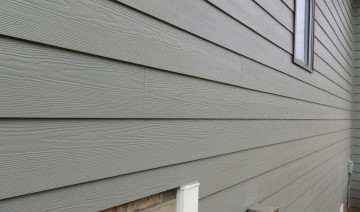{article.name}
Social Media Links
When to Know If It’s Time for Siding Replacement

- Share this:
- Share on Facebook
- Pin on Pinterest
- Tweet on Twitter
Siding is an essential part of a building’s structure, providing both protection from the elements as well as aesthetic appeal. As siding ages and becomes worn, however, it becomes less effective and needs to be replaced. Recognizing the signs of ineffective siding is important for homeowners to be able to plan for siding replacement before poor siding leads to more extensive damage and problems.
Signs Your Home Needs New Siding
Few homeowners think much about their siding, but like our own healthy skin, siding is a building’s skin that protects it from outside influences. There are many clues that may indicate siding needs to be replaced, and staying alert to these indications can help homeowners keep their property in the best condition.
- Blisters or Bubbles – If visible blisters, bubbles, or bumps are appearing on the siding, that is an indication that moisture has gotten underneath. Over time, this can lead to rot in the wood frame and more extensive structural damage.
- Fungus, Mold, or Mildew – Another sign of moisture intrusion, any indication of fungus, mold, or mildew growing on the siding can indicate that weatherproofing has failed. If mold is appearing inside, that can also show that the exterior siding has been compromised.
- Interior Damage – In addition to mold appearing inside, if interior paint is starting to crack or bubble or if wallpaper has started to peel, the siding may be permitting moisture to pass through and compromise the wall’s overall structure.
- Cracks or Breaks – If the siding has become brittle or rotted, it no longer offers effective protection against the elements. This might be noticed as cracks, breaks, holes, chips, or other damage without any obvious cause.
- Warping – Siding may eventually warp, causing gaps between panels where rain, snow, or ice could get in, or providing an entrance for bugs and wildlife. This might be seen if siding panels slip or sag, or if joints are no longer snug or tight.
- Infestations – If bugs or wildlife have gotten underneath siding, particularly if the infestation is extreme, the siding is undoubtedly failing and ready to be replaced. Woodpeckers digging for insects in wood siding can be another indication of damaging infestations.
- Drafts – Noticeable drafts when windows and doors are closed may be signs that parts of the siding have weakened and are letting stiff breezes penetrate the house. When winds are high, it may even be possible to hear siding creak and shift.
- Higher Energy Bills – If heating and cooling costs suddenly rise without corresponding rate increases, appliance use, or other causes, there may be a problem with the siding as it is no longer helping protect the house from temperature extremes.
- Severe Fading – If siding has faded far from its original color or if a chalky coating can be easily wiped off, the weatherproofing has likely worn out and the siding is no longer as protective as it is meant to be.
- Frequent Repainting – Most houses need to be repainted every 8-10 years to look their best, but if the siding needs repainting much more frequently, such as every 4-5 years, it is no longer holding paint or weatherproofing and should be replaced.
- Poor Curb Appeal – If you simply no longer enjoy the look of your home or if a poor color or outdated siding choice makes the house look worn, it may be time to repaint or replace the siding. If you may plan on selling soon, the improved curb appeal can bring a higher price.
How frequently siding will need to be replaced will depend on many factors, such as the siding type, the care it has received, what exposure it has to extreme environmental conditions, and what other stressors may have an impact, but once these signs appear, it is best to investigate siding replacement.
Protecting Your Siding
While all siding will eventually show wear and need repairs or replacement, there are steps every homeowner can take to protect their siding and lengthen its effective lifespan. To keep siding at its best…
- Inspect the siding regularly for any signs of wear, damage, or deterioration so minor issues can be corrected before they become major problems.
- Choose the best quality siding for the available budget, to ensure a good product that will last longer and be more effective against stress.
- Prune nearby landscaping and tree branches regularly to prevent any scraping or rubbing against siding that can cause damage.
- Consider investing in exterior pest control treatments that will discourage insects and keep invaders from getting underneath the siding.
- Take great care with any changes to the siding, such as installing a basketball hoop or other fixtures to the siding, to minimize the risk of damage.
- Protect siding from unnecessary impacts, such as the pressure from ladders, children throwing balls on the siding, or similar incidents that could cause damage.
Siding is an important part of any home’s structural integrity, and easily recognizing the signs of siding wear can help homeowners decide when repairs or replacement are necessary. Staying alert to siding’s condition, as well as being careful with existing siding, can help protect this investment and the home it covers.
Sign up for our Email List
Stay updated with all our latest posts, products and offers! Just enter your information below.


Comments